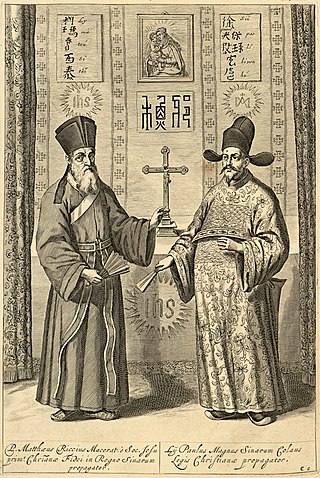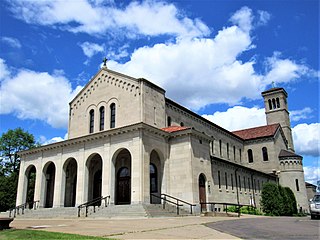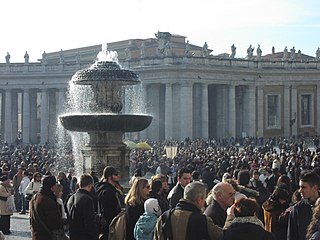
The Lateran Treaty was one component of the Lateran Pacts of 1929, agreements between the Kingdom of Italy under King Victor Emmanuel III and the Holy See under Pope Pius XI to settle the long-standing Roman Question. The treaty and associated pacts were named after the Lateran Palace where they were signed on 11 February 1929, and the Italian parliament ratified them on 7 June 1929. The treaty recognized Vatican City as an independent state under the sovereignty of the Holy See. The Italian government also agreed to give the Roman Catholic Church financial compensation for the loss of the Papal States. In 1948, the Lateran Treaty was recognized in the Constitution of Italy as regulating the relations between the state and the Catholic Church. The treaty was significantly revised in 1984, ending the status of Catholicism as the sole state religion.

The Concordat of 1801 was an agreement between Napoleon Bonaparte and Pope Pius VII, signed on 15 July 1801 in Paris. It remained in effect until 1905, except in Alsace-Lorraine, where it remains in force. It sought national reconciliation between revolutionaries and Catholics and solidified the Roman Catholic Church as the majority church of France, with most of its civil status restored. This resolved the hostility of devout French Catholics against the revolutionary state. It did not restore the vast Church lands and endowments that had been seized during the Revolution and sold off. Catholic clergy returned from exile, or from hiding, and resumed their traditional positions in their traditional churches. Very few parishes continued to employ the priests who had accepted the Civil Constitution of the Clergy of the revolutionary regime. While the Concordat restored much power to the papacy, the balance of church-state relations tilted firmly in Napoleon's favour. He selected the bishops and supervised church finances.
A concordat is a convention between the Holy See and a sovereign state that defines the relationship between the Catholic Church and the state in matters that concern both, i.e. the recognition and privileges of the Catholic Church in a particular country and with secular matters that affect church interests.

The Reichskonkordat is a treaty negotiated between the Vatican and the emergent Nazi Germany. It was signed on 20 July 1933 by Cardinal Secretary of State Eugenio Pacelli, who later became Pope Pius XII, on behalf of Pope Pius XI and Vice Chancellor Franz von Papen on behalf of President Paul von Hindenburg and the German government. It was ratified 10 September 1933 and it has been in force from that date onward. The treaty guarantees the rights of the Catholic Church in Germany. When bishops take office Article 16 states they are required to take an oath of loyalty to the Governor or President of the German Reich established according to the constitution. The treaty also requires all clergy to abstain from working in and for political parties. Nazi breaches of the agreement began almost as soon as it had been signed and intensified afterwards leading to protest from the Church including in the 1937 Mit brennender Sorge encyclical of Pope Pius XI. The Nazis planned to eliminate the Church's influence by restricting its organizations to purely religious activities.

The Catholic Church in France is part of the worldwide Catholic Church in communion with the Pope in Rome. Established in the 2nd century in unbroken communion with the bishop of Rome, it is sometimes called the "eldest daughter of the church".

Pietro Gasparri was a Roman Catholic cardinal, diplomat and politician in the Roman Curia and the signatory of the Lateran Pacts. He served also as Cardinal Secretary of State under Popes Benedict XV and Pope Pius XI.

The Catholic Church in China has a long and complicated history. John of Montecorvino was the first Catholic missionary to reach China proper and first bishop of Khanbaliq during the Yuan dynasty (1271–1368).

The 1905 French law on the Separation of the Churches and State was passed by the Chamber of Deputies on 3 July 1905. Enacted during the Third Republic, it established state secularism in France. France was then governed by the Bloc des gauches led by Émile Combes. The law was based on three principles: the neutrality of the state, the freedom of religious exercise, and public powers related to the church. This law is seen as the backbone of the French principle of laïcité (secularism). It is however not applicable in Alsace and Moselle, which were part of Germany when it was enacted.

Ludwig Kaas was a German Roman Catholic priest and politician of the Centre Party during the Weimar Republic. He was instrumental in brokering the Reichskonkordat between the Holy See and the German Reich.

Luigi Maglione was an Italian Cardinal of the Roman Catholic Church. He was elevated to the cardinalate in 1935 and served as the Vatican Secretary of State under Pope Pius XII from 1939 until his death. Pius XII never replaced Maglione, opting to assume the responsibilities of the office himself, with the assistance of two undersecretaries.

The Diocese of Superior is a Latin Church ecclesiastical territory, or diocese, of the Catholic Church in northwest Wisconsin in the United States. Its episcopal see is Superior, and the Cathedral of Christ the King in Superior is its mother church. It is a suffragan diocese of the metropolitan Archdiocese of Milwaukee.

The Diocese of Metz is a Latin Church ecclesiastical territory or diocese of the Catholic Church in France. In the Middle Ages it was a prince-bishopric of the Holy Roman Empire, a de facto independent state ruled by the prince-bishop who had the ex officio title of count. It was annexed to France by King Henry II in 1552; this was recognized by the Holy Roman Empire in the Peace of Westphalia of 1648. It formed part of the province of the Three Bishoprics. Since 1801 the Metz diocese has been a public-law corporation of cult. The diocese is presently exempt directly to the Holy See.
The Section for Relations with States or Second Section of the Secretariat of State is the body within the Roman Curia charged with dealing with matters that involve relations with civil governments. It has been part of the Vatican Secretariat of State since 1909.

Bonaventura Cerretti was an Italian cardinal of the Roman Catholic Church. He served as Prefect of the Supreme Tribunal of the Apostolic Signatura from 1931 until his death, and was elevated to the cardinalate in 1925.

Holy See–France relations are very ancient and have existed since the 5th century. They have been durable to the extent that France is sometimes called the eldest daughter of the Church.

The reorganization of occupied dioceses during World War II was an issue faced by Pope Pius XII of whether to extend the apostolic authority of Catholic bishops from Nazi Germany and Fascist Italy to German-occupied Europe during World War II.
The 1847 Agreement between the Holy See and the Russian Empire was a diplomatic arrangement entered into on 3 August of that year.

Catholic laity are the ordinary members of the Catholic Church who are neither clergy nor recipients of Holy Orders or vowed to life in a religious order or congregation. Their mission, according to the Second Vatican Council, is to "sanctify the world".

The Concordat in Alsace-Moselle is the part of the local law in Alsace-Moselle relating to the official status accorded to certain religions in these territories.
The Law of Guarantees, sometimes also called the Law of Papal Guarantees, was the name given to the law passed by the senate and chamber of the Parliament of the Kingdom of Italy, 13 May 1871, concerning the prerogatives of the Holy See, and the relations between state and church in the Kingdom of Italy. It guaranteed sovereign prerogatives to the pope, who had been deprived of the territory of the Papal States. The popes refused to accept the law, as it was enacted by a foreign government and could therefore be revoked at will, leaving the popes without a full claim to sovereign status. In response, the popes declared themselves prisoners of the Vatican. The ensuing Roman Question was not resolved until the Lateran Pacts of 1929.














